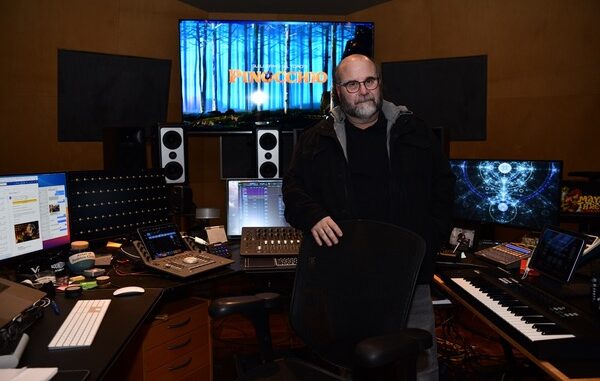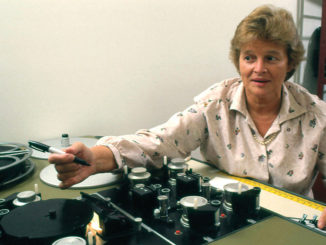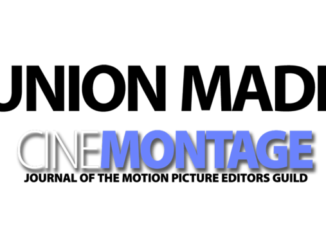
By Rob Feld
“Sound always tickled the pleasure centers of my brain,” said Scott Gershin, who recently completed work as Sound Designer and Supervisor on “Guillermo del Toro’s Pinocchio.”
“And I liked how sound induced certain emotions in people.”
Gershin has had quite the career trajectory. He studied at the Berklee College of Music as well as taking computer courses at MIT at night. When he got to Los Angeles thinking he might be anything from a visual effects artist to a rock star, he worked programing synthesizers for session players. “I was creating clavinets, French horns, trombones, string patches, etcetera, but upon playing with them I’m thinking, ‘Man, this would be a great spaceship! This would be a great laser!’ And I got a chance to learn a lot of the best audio gear—the vintage gear in its day—which was critical to my upbringing without me even knowing it.”
Gershin’s talents for manipulating sound, and knack for computers, were discovered quickly enough to have him branded “The Kid,” and soon he was working repeatedly for the likes of Oliver Stone, Wolfgang Petersen, Edward Zwick, Sam Raimi, Michael Mann, and countless others. Later career repeat collaborations with Guillermo del Toro brought him to the director’s stop-motion animation reimagining of Carlo Collodi’s book “Pinocchio,” now streaming on Netflix. As del Toro describes, this darker, more existential vision than prior adaptations casts the wooden boy as a blank slate, sent “to find out who he is, what he’s doing in this world, and why he exists.”
CineMontage: How do you see sound working on an audience in general?
Scott Gershin: When listening to music in addition to listening to the melody of the piece, I also loved the tone, the arrangement, the different counter-melodies, which allowed my brain to see the music and feel the music, it triggered my imagination. It allowed me to experience stories in my head. When watching a movie and listening to its soundtrack, which includes dialogue, sound effects and music, I think of it all as music. The way a great actor can deliver lines, it’s like listening to Billy Holiday sing. Great actors play with rhythms. When an actor sets up a temp as they deliver their lines the other actor can match it or decide to slow it down. Then all of a sudden, you’ve got one rhythm here and a different rhythm there, and they create rhythmical dissonance, which creates tension. For example, what Jack Nicholson did in “The Shining,” where he delivers his lines constantly changing his rhythm to create subliminal tension — composers and sound designers use this technique to help enhance a story. How you use audio can help an audience laugh or feel uncomfortable. I’m a student of is how sound affects your oral senses, how it makes you react—the psychology of audio.
CineMontage: Can you describe the biology behind it?
Scott Gershin: Absolutely. There’s a reason why minor tones were considered the sounds of the devil. It’s about sympathetic vibrations. When something vibrates, if its harmonics are subdivided into its family of sympathetic harmonics, like how the numbers 16 and 8 are evenly divisible by 4 and even 2. If they were frequencies, they would all share similar harmonics—AKA 3rds, 5ths, and 7ths—And our bodies go, Ooh, it’s pleasing, balanced and pretty. It all vibrates sympathetically. Then when you start taking minor tones and complex tones, instead they do this thing called beating, where two tones will beat against each other in a dissonant way. So, when you take a minor second on a string, all of a sudden you go, Ooh, tension, two notes that don’t share the same vibrations. They clash. The same thing with rhythm. Rhythm can be very insightful—I can tell the emotion of a person by the rhythm or gate of their walk. When approaching a project, I like to take all the sonic paint brushes that I have to help propel the story and push tension and release, which is really the heart of great storytelling, and great music. We like the tempos of 60 bpm or 120 bpm for a reason. Our heart beats around 60 beats per minute. But if you create a rhythm at, let’s say 75 bpm, which is little bit faster but slightly different than your internal rhythm, it can add a little bit of dissonance or tension. Another example of creating a reaction from people is scratching your nails on a chalkboard. You start learning what sounds people react to as well as how and why they react.
CineMontage: Is all of this universal?
Scott Gershin: I do a lot of work internationally and I always have to understand each culture’s sensibilities of sound, which are different. Hollywood loves low end. It goes back to rock and roll. See the big rock concert, the drum bass goes boom, lights shoot on and everybody’s heart rate goes up. Americans love that low end response. They just want to rock the room. While I am generalizing, each culture has a history with difference instrumentations, which affects the way they have heard tones. Some cultures were brought up with metallic instruments and have become accustomed to those frequencies and harmonics while other cultures were exposed to more wood and string-based instruments and are used to hearing different tonal structures. I found that some cultures loved tube amps while others liked the high end of solid state. This applies to creature vocals. Does the culture like high frequency screams like “Godzilla” or low guttural creatures that vibrate the room like “Jurassic [Park]”’s T-Rex? When creating creature sounds in different countries, this has become evident. With this said, the world has become so intermixed that our audio references are changing with each generation. Also, can that culture play back sub frequencies without pissing off the neighbors?
CineMontage: Let’s talk about “Pinocchio.” How do you work with del Toro and how did you find the sound to represent the character?
Scott Gershin: He’s an amazing artist and his visual sense is off the charts. When we start working together on a project, he wants to hear something from me first and then we’ll go from there. He doesn’t like to talk about audio hypothetically. We have a vocabulary with each other, and I have a good sense of what he likes, so some things came quickly, but what I found challenging and what required a journey was to find the sound of Pinocchio. Let’s start with wood, so you bang pieces of wood together and you go, “Well that doesn’t work.” Then you say, “Hey, he’s a puppet, let me get some old puppets.” But they’re like bowling pins and they just klonk together. So then, as a guitar player I got this wild idea. I contacted PRS Guitars. I own a bunch of them and on YouTube saw how they make them on a computer numerical control machine. They cut out the form and wind up with lots of interesting, tonal, spare scrap wood. So, they sent me 50 pounds of wood to play with. Some of it was too tonal so I had to use it strategically. I started experimenting with a Foley artist, Dan O’Connell. It became months of trying different woods and other materials in different combinations. We realized, “Wow, Pinocchio can get really annoying!” If we just were clacking away. And then to make it even more fun, Geppetto wears wood shoes, so everybody’s clacking away. While we may have been sonically correct, it felt like Pinocchio was becoming annoying; the total opposite of what I was striving for. Then I thought about putting in squeaks and creeks and it got a lot more interesting, switching between metal and rubber and woods. Pinocchio’s aural vocabulary was coming into view. Like, when Pinocchio waves an innocent little wave while in the closet, we gave him a little squeak. It had to be “the right squeak” to convey innocence. Each of the characters had their signature sounds. Volpe always had coins in his pockets and occasionally loved to tap dance. Podesta had an authoritative walk. For the Forest Sprite and Death, I created a special treatment on their dialogue to create a sense of godliness and higher being.
CineMontage: It’s where storytelling comes in.
Scott Gershin: You have to ask, “What is the underlying story?” I treated it a little bit like Frankenstein. When Pinocchio gets created, he’s epitome of innocence. Big clacky wood is not innocence. It’s just big clacky wood. Guillermo and I were talking and felt Pinocchio should have a fragility like he could fall apart at any time, very loosely built; I wanted him to have a slightly creature feel when Geppetto first sees him, as he’s stretching, cracking; a little spidery coming to life for his big reveal. One of the elements I used was cracking walnuts for his joints coming into place, as well as metallic and stretched rubber. I even used a ratchet that pays homage to the cartoon world to give the audience a sound they might be familiar with as they are deciding if he is he good or bad. I recorded a lot of material to finally get to where we wanted it. That was important because we don’t think of him as the character Pinocchio yet. He’s still this thing, an it, but then we have to evolve him into becoming a lovable character. So, as he evolves emotionally, the sound has to subtly evolve. Little by little, we started losing some of his fragility and the looseness. In the end, Pinocchio is made up of about eight different elements—different woods, wood squeaks, creeks, metal squeaks to name a few—it had to be weaving through the whole show. I spent a lot of time pitching, time shifting, equalizing, phrasing rhythms and different elements together. It’s a tapestry; it’s never one sound. I found that it needed to be a little bit of this, a little bit of that. Even on the stage working with re-recording mixer Frank Montaño, I had all the elements separate so that at any moment we could push and pull against what Alexandre Desplat’s music may be doing—to complement or contrast it—with certain sounds playing better through the music than others. It was a puzzle, trying to give Pinocchio “his” sound and to find the tension and releases within the story.
CineMontage: Can you give me an example?
Scott Gershin: One of my favorite parts is when Pinocchio is locked in and banging on the closet. When Geppetto opens up, he sees Pinocchio with a sock on his nose and he realizes that innocence when Pinocchio waves his hand. I started with a wood squeak but that didn’t do it. I found a very simple creaking that did it. But that’s what made Pinocchio challenging; you couldn’t put any sound. It had to be the right sound with the right rhythm. It took a great amount of experimentation and in time. Guillermo always thought that was the easy part. “This movie’s not very hard for you,” he said. I said, “Ha! I have nowhere to hide. Every sound is totally exposed. Out of the trillion sounds out there, I have to find the right one at the right point.”
Lastly what I think made the sound of this movie special was not only the specific sounds used in the movie but how and why they were used. The sound for the movie starts in mono like a puppet show and expands and evolves over time like the characters do. We’re telling a story with sound not with a single word or a sentence but with pages of evolution. Using simple sounds at the beginning, to roaring the room with Dog Fish, to ending with a soft elegant breeze.






